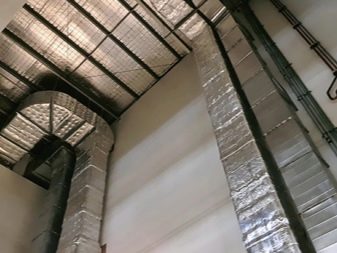What can be the insulation of air ducts and how to make it?

The operation of any ventilation system is associated with one of the most common problems - the formation of condensation as a result of temperature differences. To resolve the issue, you need to think about isolation. This is the primary task that you need to think about even at the stage of project development.


Appointment
Thermal insulation for the treatment of flue gas ducts not only prevents condensation. Additional tasks performed by the material:
- reduction of vibrations, extension of the service life of the structure;
- reduction of noise during operation;
- increasing the fire-fighting properties of the structure;
- reduction of heat losses.
Insulation is an indispensable element of the air duct.


Materials (edit)
Insulation manufacturers produce products from different materials.
- Foamed polyethylene. This option is in demand for insulating small exhaust air ducts used in homes or small industries. Some insulating materials of this type contain aluminum foil, which provides a reflective effect and enhances functionality. The advantages of polyethylene include chemical resistance and safety. The insulation easily prevents condensation and is easy to install.
- Foamed rubber... A material with improved performance characteristics, the peculiarity of which lies in a closed porous structure. Rubber perfectly resists water vapor diffusion and does not pose a threat to the environment, resistant to corrosion. The material is produced in sheets with a sticky layer, as well as in rolls with an aluminum coating.
- Mineral wool. Mineral wool insulation can be a conventional or improved foil layer. The material is produced in rolls, has high thermal insulation characteristics and increased strength. Demonstrates good performance at high temperatures and additionally acts as a sound insulation for air ducts.
- Expanded polystyrene... The peculiarities of using foam insulation include increased heat resistance due to the content of special components in the material. Other pluses: light weight, ease of installation and low thermal conductivity. Among the shortcomings, a short service life is distinguished, which requires regular renewal of the layer.


Insulation materials differ from each other in characteristics, production method and other parameters. Regardless of the type of material used, it must be borne in mind that it must have high performance characteristics.
In addition, the material must be corrosion resistant and flame retardant. Only high-quality insulation can extend the duct's service life and prevent its premature destruction.


Work technology
The stages of installation of insulation on duct elements are determined by the material with which you have to work. The scheme of thermal insulation of the ventilation system with mineral wool includes the following steps.
- Careful cleaning up pipes from any kind of pollution.
- Winding fittings a layer of mineral wool.
- Foil insulation pad, the thickness of which does not exceed 0.4 cm.
- Seam sealing with aluminum tape. It is not recommended to use nails or other types of fastening.
Foil insulation will prevent the risk of heat leakage and preserve the durability of both the duct and the mineral wool.


When using expanded polystyrene, a number of steps must be taken.
- Pre-cut the slabs into pieces of the desired size using a knife.
- Put the formed half-cylinders on the pipe with an offset of 20-25 cm for tightness of the connection.
- Close up the seams with bandages, and check the reliability of fixation of the material.
The same scheme will be used when using polyurethane foam and polypropylene insulation materials. If we are talking about the installation of foam polyethylene insulation, then here it is worth paying attention to the ventilation cross-section. Rectangular and square ducts are insulated using roll materials, from which sheets are subsequently cut. The diagram looks like this.
- First, measurements are taken.
- Next, the polyethylene sheath is opened along the seam, securing the material around the pipe.
- At the end, the joints are additionally glued with tape to increase the tightness.


Round air ducts are usually sealed with standard sheet material without a self-adhesive layer. In this case, the ends of the sheets at the joints are glued using a special compound or adhesive tape. If the air duct is located outdoors, then it is worth taking care of the use of external protective coatings, which will prevent a decrease in the service life of the insulation.
The installation diagram of the foam rubber insulation is slightly different. Main steps.
- Preliminary sheet marking isolation according to the previously taken dimensions of the pipeline.
- Parcel cutout, which is necessary for isolation.
- Application of special glue to the cut-out area, which will subsequently be mounted on the system.
- Applying glue to the duct. In this case, use a spatula.
- Bonding non-combustible material to the duct.


The joints formed during the gluing process are recommended to be sealed with rubber adhesive tape or PVC tape to improve the properties of both internal and outdoor heat and sound insulation... Some manufacturers produce foamed rubber in the form of sticky sheets. In this case, the installation diagram will be as follows.
- Thoroughly first cleanse and degrease duct surface.
- Next, using a ruler and tape measure carry out marking of insulation sheets, after taking measurements of the parts of the ventilation system.
- The next step is in cutting the marked sheets.
- Then carefully remove the film from the insulation, and glue the finished sheet to the surface of the duct.
After installing the sheet, irregularities and bubbles are smoothed out with a flat tool, and the joints of the material are glued on the edges of the air duct. For this, it is better to use black rubber tape or PVC tape.















The comment was sent successfully.